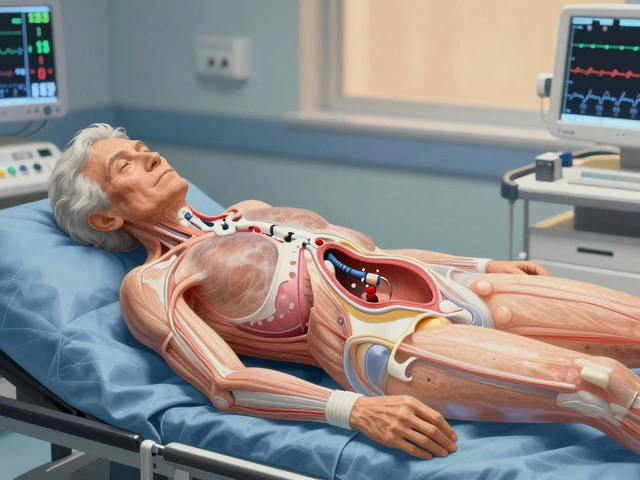So, you're wondering how long it really takes to walk normally after knee replacement surgery? Alright, let’s break it down. Post-op, the journey to getting back on your feet starts pretty soon. Yeah, you heard it right – walking is encouraged as early as the first day after surgery! Sounds crazy, but small steps with the help of a walker or crutches get your recovery on track.
Now, I'm not saying you'll be running marathons overnight. The initial phase can be challenging, but it's essential for healing. You’ll work with physical therapists who’ll guide you through exercises designed to regain strength and range of motion. Generally speaking, with regular exercises, many folks start to walk more confidently around six weeks. However, strolling confidently without aids might take a few months, depending on several factors like your age and overall health.
- Initial Days Post-Surgery
- Physical Therapy and Exercises
- Timeline for Walking Normally
- Factors Influencing Recovery
- Tips for a Smoother Recovery
- When to Seek Further Medical Advice
Initial Days Post-Surgery
Alright, so you’ve just had your knee replacement and now you're entering those crucial first few days after the surgery. It's a bit daunting, but understanding what to expect can make things go a lot smoother.
First 24 Hours
This period usually starts with a whole lot of rest. Nurses and doctors will keep a close eye on you to manage your pain and monitor your overall condition. Don’t be surprised if they encourage you to stand up and take a few steps with some help. It’s not about pushing yourself too hard, just getting the circulation going.
Days 1 to 3
By now, the physical therapy team steps in. These folks are gold. They'll begin with gentle exercises aimed at improving your mobility and strength. You'll likely use a walker or crutches initially for stability.
- Walking Shortly After Surgery: Yes, it’s possible! With aids like crutches, you begin by putting some weight on that new knee.
- Pain Management: Make sure you’re following the prescribed medicines and inform your doctor if the pain becomes a bit much.
Expect Slight Swelling
It's pretty common to have some swelling around the knee. Using ice packs and keeping your leg elevated help with this. Think of it as part of the process rather than a setback. Patience and consistency in following medical advice are keys here.
| Activity | Recommended Frequency |
|---|---|
| Physical Therapy Sessions | Daily |
| Pain Management | As required, typically every 4-6 hours |
| Ice Application | 20 minutes every hour while awake |
These initial days are about setting the foundation for a successful recovery time. With the right mindset and support, you'll be on your way to walking normally before you know it!
Physical Therapy and Exercises
Once you've gone through knee replacement surgery, physical therapy becomes your new best friend. Why? Because it’s crucial for getting you back on your feet and walking confidently. The aim here is simple: to regain strength and improve the movement of your new knee.
Initial Exercises
In the early days after surgery, your therapist will introduce basic exercises. Think of these as the building blocks for recovery:
- Quad Sets: Tighten your thigh muscles by pressing the back of your knee into the bed. Hold for a few seconds, then relax.
- Heel Slides: Slowly slide your heel towards your buttocks, bending the knee as far as it's comfortable.
- Ankle Pumps: Push and pull your toes to promote circulation and prevent blood clots.
Progression to Advanced Moves
As you grow stronger, the exercises get a bit more intense. Expect to include:
- Leg Raises: Lift your leg with a straight knee to work those quads.
- Step-ups: Practice stepping onto a low platform to mimic stair climbing.
- Stationary Cycling: Helps improve range of motion and boosts your endurance.
Working these muscles doesn’t just speed up your recovery; it also helps in preventing future injuries.
Consistency and Patience
Now, I won’t lie - you have to stay consistent with these exercises for the best results. Typically, therapy sessions start at two to three times a week, depending on how you’re progressing. And don't skip those exercises at home!
Statistics show that about 90% of knee replacement patients see significant improvement within the first year post-surgery when they stick to their therapy plans. Remember, it’s a marathon, not a sprint. Stay patient and celebrate the small wins along the way.
Additional Activities
Don't be surprised if your therapist throws in some pool therapy or light walking. Both are gentle on the new knee and excellent for regaining movement without straining.
To sum it up: Listen to your physical therapist, keep at those exercises, and soon enough you'll notice you're walking more naturally and even climbing stairs like you used to!
Timeline for Walking Normally
Alright, let's get down to specifics. Typically, after knee replacement surgery, you’re encouraged to start moving as soon as possible. But let’s map out what you can generally expect week by week.
Week 0-2: Early Days
Just after surgery, you’ll begin walking with aids like a walker or crutches. Physical therapy usually kicks off almost immediately, focusing on basic movements to prevent stiffness and increase circulation.
Week 2-6: Building Strength
In this period, you'll notice more confidence in moving around. Supervised exercises will help strengthen your muscles and improve balance. Many patients progress from walkers to canes during these weeks.
Week 6-12: Walking More Freely
By now, many patients ditch the canes and start walking unassisted for short distances, although a slight limp might still be there. It's a crucial time to listen to your body and pace yourself.
| Week | Progress |
|---|---|
| 0-2 | Walking with aids, starting physical therapy |
| 2-6 | Strengthening, transitioning to a cane |
| 6-12 | Walking independently, possibly with a limp |
Beyond 3 Months: Getting Back to Normal
Around the three-month mark, many people experience significant improvements. Walking normally without any limp becomes more common, although full recovery can sometimes take up to a year depending on personal health and how diligently you follow your therapy regimen.
With dedication to your recovery plan, you'll hopefully regain normal walking patterns and get back to doing what you love—sooner rather than later.

Factors Influencing Recovery
Recovery from knee replacement surgery varies from person to person, and several key factors can affect how quickly you get back on your feet. Let’s dive into what might influence your healing time.
1. Age and Overall Health
Age plays a significant role in recovery. Generally, younger patients tend to bounce back quicker. However, overall health is crucial too. If you’re in good shape with no underlying health conditions, you're likely to see a smoother recovery. On the flip side, conditions like diabetes or heart issues can slow things down a bit.
2. Commitment to Physical Therapy
Physical therapy is no joke when it comes to rebuilding strength and flexibility. The more committed you are to the exercises, the better your recovery. Skipping sessions might sound tempting, but consistency is key for getting back to normal walking.
3. Weight and Lifestyle
Carrying extra weight can put added stress on your new knee, potentially complicating recovery. Lifestyle habits, like smoking or poor diet, can also have a negative impact on healing. Eating right and quitting smoking can make a noticeable difference.
4. Surgical Technique
Believe it or not, the surgical approach used by your orthopedic surgeon can affect recovery time. Minimally invasive techniques often result in quicker recovery and less pain, so it's good to have a chat with your doctor about what to expect based on the method they use.
5. Post-Surgery Care
How well you follow post-surgery instructions can be the make-or-break factor in your recovery. Keeping up with at-home exercises, managing swelling, and attending follow-up appointments can keep things on track.
| Recovery Factor | Impact |
|---|---|
| Age | Younger individuals often heal faster |
| Health Conditions | Can slow recovery or complicate the process |
| Engagement in Therapy | Greater effort typically leads to faster progress |
| Weight | Additional weight can stress the joint |
In a nutshell, a successful and timely recovery from a knee replacement hinges on multiple factors. Understanding these can help set realistic expectations and plan for the best outcome.
Tips for a Smoother Recovery
Knee replacement recovery can feel like a long road, but there are several tried-and-true tips to ease the journey. If you're aiming to walk normally faster, pay close attention to the advice below.
1. Stick to Your Physical Therapy
Your physical therapist is your best friend during recovery. PT sessions are designed to boost strength and flexibility in your new knee. Missing sessions or slacking off on homework exercises hampers progress. So, stay committed – it’s one of the most crucial steps for knee replacement recovery.
2. Follow a Balanced Diet
Fueling your body with the right nutrients can accelerate healing. Incorporate proteins, vitamins, and minerals, alongside plenty of water. This combo aids tissue repair and keeps energy levels high, essential factors when you're working on walking after surgery.
3. Manage Swelling and Pain
Ice packs are magical in the early days. Regular icing reduces swelling, much-needed for getting back on your feet. Pair it with prescribed pain relief and follow dosage instructions to avoid over-reliance on meds.
4. Don't Skip the Rest
Yes, exercise is vital, but so is rest. Balance activity with downtime to give your knee ample time to recover. Overexertion can set you back in your goal to achieve normal walking post-knee surgery.
5. Use Assistive Devices
Crutches or walkers aren't signs of weakness; they’re tools to protect while you regain stability. Use them for as long as recommended. Rushing to ditch them can lead to accidents or setbacks.
6. Keep a Recovery Journal
Tracking your progress can be incredibly motivating. Note milestones, exercises, and any challenges faced. It's a great way to reflect on improvement and adjust your approach with your healthcare team.
Implementing these tips won’t just speed up your recovery; they’ll enhance the quality of your rehab, ensuring you get back to your daily routine sooner. Take it one step at a time, literally!
When to Seek Further Medical Advice
Okay, so you've had your knee replacement surgery, and you're on the road to recovery. But how do you know when something isn't quite right, when it's time to check in with your doctor? Let's look at some red flags you shouldn't ignore.
Persistent Pain and Swelling
Some pain and swelling are normal, but if it's intense or not improving over time, it might be a sign of a potential issue. Generally, swelling should decrease after a couple of weeks, and severe pain should subside as well. If it doesn’t, make a call to your health professional.
Signs of Infection
Though infections are rare, they happen. Watch out for symptoms like fever, chills, or the incision area becoming excessively red, warm, or oozing pus. These aren’t just minor concerns – they're reasons to get in touch with your doctor immediately.
Difficulty in Movement
If your knee replacement feels overly stiff or locked, and exercises or therapy don’t seem to help, it could be a reason to seek advice. Movement should progressively improve, not decline.
Unusual Blood Clots
Blood clots are a known risk after knee surgery. Pain or swelling in your calf, shortness of breath, or chest pain, could indicate a clot. These symptoms are serious – don’t hesitate to get immediate medical care.
| Symptom | Action |
|---|---|
| Severe, persistent pain | Contact doctor |
| Intense swelling | Schedule a check-up |
| Fever or chills | Seek immediate consultation |
| Calf pain or swelling | Go to ER |
Emergent Situations
Some symptoms demand instant action. Things like sudden chest pain, difficulty breathing, or fainting spells are non-negotiable. Get emergency help without delay.
So, if you're facing any of these issues post knee replacement, consult your orthopedic team. It's always better to be on the safe side when it comes to your health.









